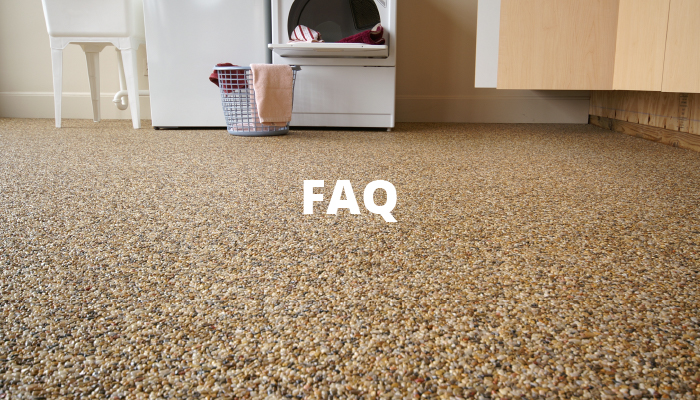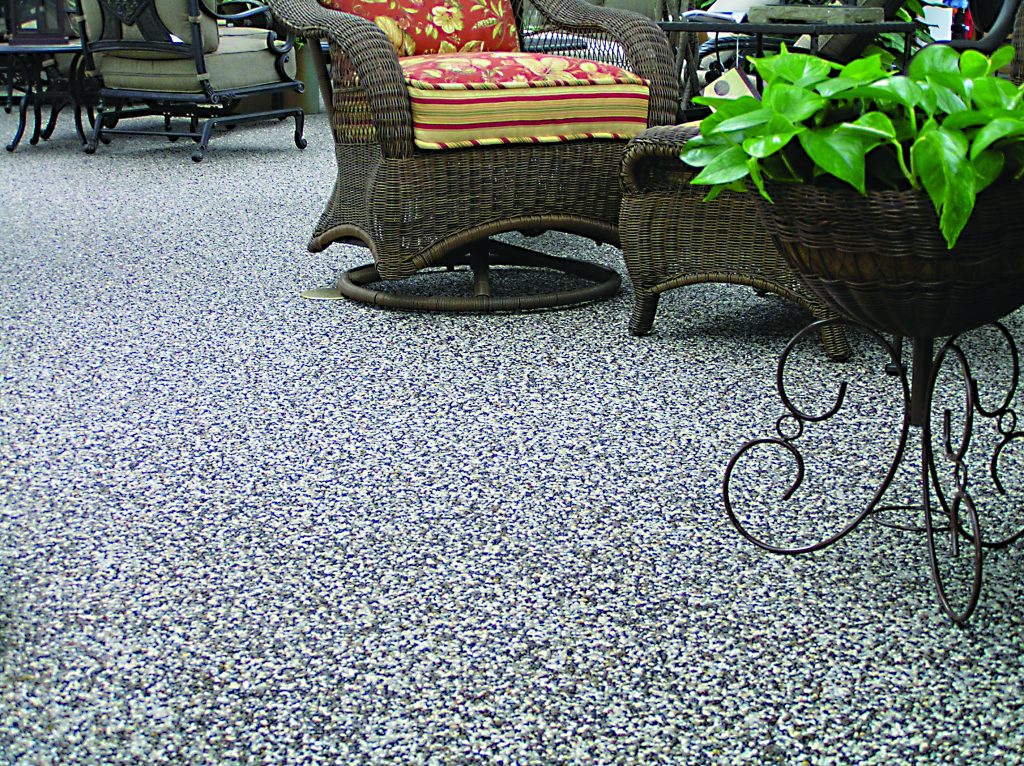Discovering the Beauty and Durability of Stone and Epoxy Flooring: A Comprehensive Overview
Stone and epoxy flooring are two incredible options for elevating the visual appeal and longevity of your spaces. In this listicle format, we’ll break down these two choices and their benefits for you:
Stone Flooring: A Timeless Classic
- Stone flooring incorporates natural materials like marble, granite, limestone, or slate.
- The inherent beauty and durability of stone have made it a go-to choice for centuries.
- Each stone type boasts distinct patterns, colors, and textures, offering endless design possibilities.
- The natural variations in stone create a unique, character-rich look that complements any space.
- You’ll often find stone flooring in high-end homes, hotels, and commercial structures.
Epoxy Flooring: Modern Versatility
- Epoxy flooring is a contemporary favorite, recognized for its adaptability and toughness.
- This option involves applying a robust and protective epoxy resin coating onto an existing concrete floor.
- Epoxy coatings are available in a wide spectrum of colors and finishes, including metallic, flake, and solid colors.
- This variety ensures a customized look that matches various design preferences and functional requirements.
- Epoxy flooring is a cost-effective solution to transform plain concrete floors into visually appealing, high-performance surfaces.
Aesthetic Appeal and Practical Benefits
- Both stone and epoxy flooring offer not only aesthetic charm but also a plethora of practical advantages.
- Stone flooring is naturally moisture-resistant, making it perfect for spaces susceptible to spills and moisture buildup.
- Cleaning and maintenance are a breeze, requiring only regular sweeping or mopping.
- Epoxy flooring, in contrast, boasts high resistance to chemicals, stains, and impacts.
- Its seamless and non-porous surface is impervious to bacteria growth, making it an excellent choice for healthcare facilities, restaurants, and industrial spaces.

Benefits of Stone and Epoxy Flooring
Durability:
Stone and epoxy flooring are known for their exceptional durability. Stone floors, such as marble, granite, or slate, are natural materials that can withstand heavy foot traffic and resist scratches, stains, and wear. Epoxy flooring, on the other hand, is made up of a tough resin that provides a strong and long-lasting surface. Both options are highly resistant to impact, making them ideal for areas with high usage.
Versatility:
Stone and epoxy flooring offer a wide range of design options, allowing you to create a unique and personalized space. With stone flooring, you can choose from various colors, patterns, and finishes to match your aesthetic preferences. Epoxy flooring, on the other hand, can be customized with different colors, textures, and even 3D designs, providing endless possibilities for creativity.
Low Maintenance:
Stone and epoxy flooring are both easy to maintain, making them suitable for busy environments. Stone floors are naturally resistant to dirt and debris, requiring minimal effort to keep clean. Regular sweeping and occasional mopping are usually enough to maintain their appearance. Epoxy flooring is seamless and non-porous, preventing dirt, dust, and liquids from penetrating the surface. This makes it easy to wipe away spills and stains, requiring only regular sweeping or light mopping.
Hygienic:
Both stone and epoxy flooring are hygienic options for various environments. Stone floors are naturally resistant to bacteria, allergens, and mold, making them ideal for spaces where cleanliness is crucial, such as kitchens and bathrooms. Epoxy flooring, with its seamless and non-porous surface, prevents the growth of bacteria, mold, and mildew, making it a suitable choice for healthcare facilities, laboratories, and food processing areas.
Cost-Effective:
Despite their initial cost, stone and epoxy flooring can be considered cost-effective options in the long run. Stone floors are incredibly durable and can last for decades when properly maintained, eliminating the need for frequent replacements. Epoxy flooring, with its long lifespan and low maintenance requirements, also helps save on repair and replacement costs over time. Additionally, both options are resistant to moisture and stains, reducing the chances of damage and the need for costly repairs.
How to Install Stone and Epoxy Flooring
Installing stone and epoxy flooring can be a relatively simple process if you have the right tools and materials. Here are some steps to help guide you through the installation process:
Prepare the surface: Before installing stone and epoxy flooring, it is important to prepare the surface properly. Remove any existing flooring or adhesive, and make sure the surface is clean and dry. If there are any cracks or uneven areas, fill them with a suitable filler and allow it to dry completely.
Choose the right stones: Selecting the right stones for your flooring is crucial to achieve the desired look. Consider the size, shape, and color of the stones that will complement your space. It is recommended to purchase extra stones to account for any breakage or mistakes during the installation process.
Mix the epoxy: Epoxy is a two-component mixture that needs to be mixed properly before application. Follow the manufacturer’s instructions on the packaging to ensure the correct ratio of resin and hardener. Use a clean container and mix the epoxy thoroughly until it reaches a uniform consistency.
Apply the epoxy: Start by applying a thin layer of epoxy on the prepared surface using a roller or brush. This will act as a base coat and help the stones adhere properly. Work in small sections to ensure the epoxy does not dry before placing the stones.
Place the stones: Carefully place the stones onto the epoxy base coat, pressing them firmly to ensure good adhesion. Arrange the stones in a pattern or design of your choice. Leave a small gap between the stones to allow for the grout to be applied later.
Fill the gaps: Once the stones are in place, mix a suitable grout according to the manufacturer’s instructions. Fill the gaps between the stones with the grout using a grout float or a trowel. Remove any excess grout from the surface of the stones using a damp sponge or cloth.
Allow the flooring to cure: After completing the installation, allow the epoxy and grout to cure for the recommended time specified by the manufacturer. This typically ranges from 24 to 48 hours. Avoid walking or placing heavy objects on the flooring during this curing period.
Seal the flooring: To protect the stone and epoxy flooring and enhance its durability, it is recommended to apply a sealer. Choose a sealer specifically designed for stone and epoxy flooring and follow the manufacturer’s instructions for application.
Maintenance Tips for Stone and Epoxy Flooring
Regular Cleaning:
Regular cleaning is essential for maintaining the beauty and longevity of stone and epoxy flooring. Sweep or vacuum the floor regularly to remove dust and debris. Use a soft-bristle broom or a vacuum cleaner with a hard-floor attachment to prevent scratching the surface.
Avoid Harsh Chemicals:
When cleaning stone and epoxy flooring, it is important to avoid using harsh chemicals that can damage the surface. Opt for pH-neutral cleaners specifically designed for stone or epoxy floors. Avoid using acidic or abrasive cleaners, as they can scratch or etch the surface.
Prompt Spill Cleanup:
Spills should be promptly cleaned up to prevent staining or damage to the stone or epoxy flooring. Use a soft, absorbent cloth or paper towel to blot and remove the spill. Avoid rubbing the spill, as it can spread and result in more extensive staining.
Protect from Scratches:
To protect stone and epoxy flooring from scratches, use felt pads or furniture glides under the legs of furniture. This prevents the furniture from scratching or scuffing the floor when moved. Avoid dragging heavy objects across the floor, as it can also cause scratches.
Avoid Excessive Moisture:
Excessive moisture can be detrimental to stone and epoxy flooring. Avoid using excessive water when cleaning the floor, as it can seep into the joints or cracks and cause damage. If spills occur, ensure they are promptly cleaned up and the area is thoroughly dried.
Periodic Sealing:
Stone flooring may require periodic sealing to maintain its appearance and protect it from stains. Consult the manufacturer’s guidelines or seek professional advice on the appropriate sealing schedule for your specific type of stone flooring. Epoxy flooring typically does not require sealing.
Regular Maintenance Inspections:
Regularly inspect the stone and epoxy flooring for any signs of damage or wear. Look for cracks, chips, or areas where the finish may have worn off. Promptly address any issues to prevent further damage and maintain the overall condition of the floor.
Professional Maintenance:
Consider hiring professional maintenance services for deep cleaning and maintenance of stone and epoxy flooring. Professionals have the expertise and tools to effectively clean and maintain these types of flooring, ensuring they remain in optimal condition for years to come.
Polyaspartic Vs. Epoxy Garage Floor Coating Best Materials
Stone Pebble Epoxy Flooring – Concrete Resurfacing and Floor Coatings
Outdoor Stone Flooring Applications
Related Posts:
- Two Part Epoxy Floor Coatings That Are 100 Solids
- Valspar Floor Epoxy
- New Era Epoxy Flooring
- Clear Self Leveling Floor Epoxy
- Commercial Grade Epoxy Floor Coating
- Rustoleum Epoxy Professional Floor Coating
- Epoxy Flooring Services
- How To Install Epoxy Floor In Garage
- Epoxy Flooring Per Square Foot
- Benefits Of Epoxy Flooring In Garage





